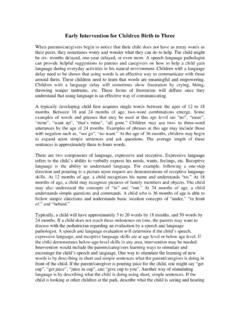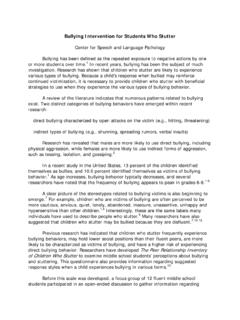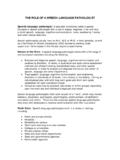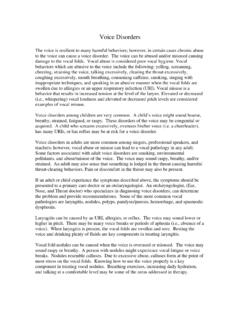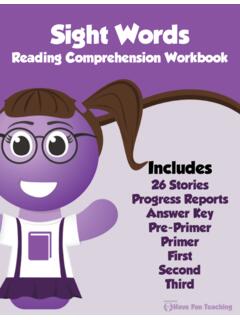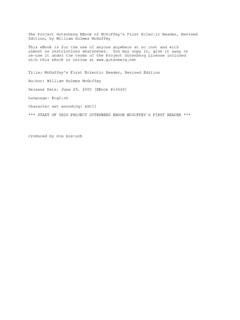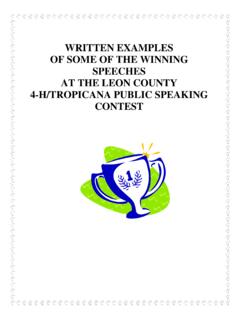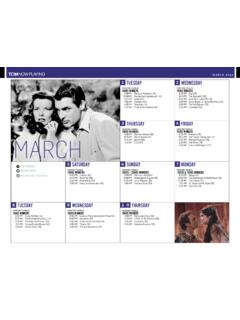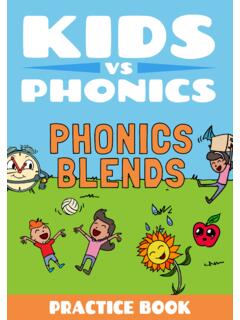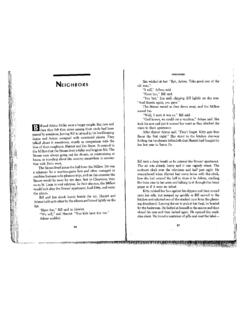Transcription of Child Narrative Development
1 Child Narrative Development Children with language impairments tend to have difficulties with producing as well as comprehending narratives. Narrative tasks require the use of various skills including but not limited to organization, sequencing, establishing the main idea, and perspective taking. The following are excerpts from various articles regarding Narrative types and developmental stages. According to Hedberg and Westby (1993), there are various types of narratives. Scripts: This form of Narrative is used to express knowledge of a familiar, recurring event. It is usually told using the second person pronoun you and the present tense. Recounts: This involves telling about a personal experience when prompted most often using the past tense. Accounts: We explain a personal experience without a prompt. The experience is usually not shared by the listener.
2 Event Casts: Explaining an ongoing activity, reporting on a factual scene, or telling about a future plan. Fictional Stories: Relating past, present, or future events that are not real. The events being described focus on someone or something attempting to carry out a goal. The following is an outline of what to expect during your Child s early Narrative Development . (Hedburg and Stoel-Gammon, 1986, ) Stage I: Heaps (2yrs) Your Child may relate a collection of unrelated ideas. The topic of discussion switches frequently and cohesive devices are not used to link the story together. Simple present progressive tense is used. Example: A girl is eating cookies. The man is going to the car. The baby is sleeping. Stage II: Sequences (2-3yrs) During this stage, your Child may begin to arbitrarily link story elements together. A sequence contains a central character, topic, or setting.
3 Example: She lives with her dad. She lives with her mother. Grandma and Grandpa live together. And these three children live with their grandma. And these two animals live with them. Stage III Primitive Narratives (3-4yrs) Primitive narratives, like sequences, contain a central character, topic, or setting. What distinguishes them from sequences is the Child s discussion of the character s facial expressions or body postures. Example: My dad, he went up to go to work. My mom stayed and sleep in. My two brothers, they went to go play with the toys. My dog, she went outside. My kitty cat came up and he tickled me and came up and started to meow. And then I started to cry because he bit me. And my brothers came runnin in and Mike said, What happened? They said, What happened? My kitty cat just bit me. So mom comes runnin in and she said, What happened?
4 Oh the kitty cat bit you. Unfocused Chains (4-4 yrs) An unfocused chain does not contain a central character. It is a sequence of events which are linked logically or with a cause-effect relationship. The conjunctions and, but, and because may be used. Example: This man is walking. He saw a dog and a cat and he saw a girl too, with the cat and the dog. He said, Hello. He walked back and he said, Brother, come here. So her grandmother walked up to her and said, You wanna go dancing? They went dancing. And so it was a slow dance. And then they went back. And then these two children came. And then first he said, I m not. And then he said, What? I want to go out to eat. So they went out to eat. Focused Chains (5yrs) Focused chains contain a central character and a logical sequence of events. The events described in these sequences take the form of adventures.
5 The listener, however, is asked to interpret the ending. Example: Once upon a time there was a mother named Christie. And she had a husband named Tom. And they had some children named Heather and Christie. And they had a boy named Ronnie. And the mother told the boy to go outside to play. And then the boy came in and said, Mother, mother, our dog s outside and he s barking. I will go see. What are you barking at? I don t know what he was barking at, Tommy, Ronnie, Ronnie. I don t know what he was barking at. You go out there and see. He wants in. I ll go let him in. There, I let him in. True Narrative A true Narrative focuses around an incident in a story. There is a true plot, character Development , and a true sequence of events. There is a problem in the story which is resolved in the end. Example: One day there was a boy named Bobby and a girl named Sharon.
6 They found a cat in their front yard and they brought it into the house. They fed the cat and they gave it some milk. They played and played with it and then a little while after a lady called and asked if anybody had seen her cat. And then they said that they had it at their house. And they brought it to the lady s house. And she gave them each five dollars for finding the cat and having them feed it and give it milk. Knowing your Child s Narrative stage of Development allows a caregiver to further develop these skills in the home environment. A parent may have a Child retell the events of their day and preview the events of the next day to help them with personal Narrative recall and sequencing. During book reading, a parent may ask questions to help highlight major components of the story ( Who was the story about? What did he do first?)
7 And then jointly summarize stories both during and after the reading. Photo albums from recent trips also serve as excellent stimuli for Narrative production practice. Story telling before bed or during car trips can also be a source of fun and an opportunity for parents to take turns modeling these skills for their children. If a Child seems to have difficulty with developmentally appropriate tasks, caregivers may want to contact the primary educators and/or a certified speech-language pathologist. Hutson-Nechkash, Peg. (2001). Narrative Toolbox: Blueprints for Storybuilding. Eau Claire, WI: Thinking Publications. Center for Speech and Language Pathology

